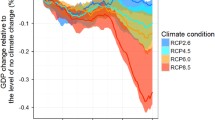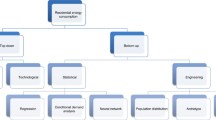Abstract
While energy savings in buildings is among the key prerequisites for a low-carbon future, our ability to maintain temperatures in buildings within a specific comfort range, and thus our demand for heating and cooling energy, are also highly sensitive to climate change. We quantify two main impact chains: (1) a higher temperature in winter leads to a reduction of heating energy demand and (2) a higher temperature in summer leads to an increase in demand for cooling. The demand for cooling energy depends largely on the future uptake of air conditioning in the building sector and is subject to considerable uncertainty. On quantifying these two impacts for the example of Austria for the period around 2050 a net saving of about 230 million euros per year is found, triggering slightly positive effects on welfare and GDP. The result is depending on the development of energy prices and in particular by the ratio of electricity to fuel price in the heating sector. The results show that, in absolute terms, the energy reduction in heating is much higher than the increased energy demand for cooling for the time horizon and the geographical location investigated. This stems from the fact that energy demand for air conditioning in Austria in 2008 was only 0.4–0.5 % of the final energy demand for heating. The impacts and costs resulting from a strong increase in electricity peak loads in summer are investigated in Chap. 14 (Electricity).
Access this chapter
Tax calculation will be finalised at checkout
Purchases are for personal use only
Similar content being viewed by others
Notes
- 1.
On the relation between indoor comfort and control strategies see e.g. Roberts (2008).
- 2.
Based on extrapolation of “Energieszenarien bis 2050: Wärmebedarf der Kleinverbraucher“ on the reference scenario.
- 3.
Climate adjustment has been carried out for the year 2010 according to the mid-range climate scenario of Chap. 5 (Climate).
- 4.
We are aware that the RCP scenarios derived for the IPCC AR5 would be more up-to date. However, at the time when the analyses in this chapter started, these results were not yet available.
- 5.
A map of these clusters is presented in the supplementary materials (Supplementary Material Fig. 13.1).
- 6.
In fact, energy prices may also be affected by climate change. This is discussed in Chap. 14 (Electricity).
- 7.
- 8.
The “rebound effect” is neglected in the macroeconomic assessment. Some aspects of the rebound-effect are covered implicitly in Invert/EE-Lab (increased effective indoor temperature after building renovation).
- 9.
Sector “Energy” is providing electricity, gas and district heat; sector “Coke and Petroleum Products” is providing coke and fuel oil; sectors “Forestry” and “Trade” are providing biomass; sector “Trade” is providing air conditioners.
References
Aguiar R, Oliveira M, Gonccedilalves H (2002) Climate change impacts on the thermal performance of Portuguese buildings. Results of the SIAM study. Build Serv Eng Res Technol 23:223–231. doi:10.1191/0143624402bt045oa
Beccali M, Cellura M, Brano VL, Marvuglia A (2007) Short-term prediction of household electricity consumption: Assessing weather sensitivity in a Mediterranean area. Renew Sust Energ Rev 12(8):2040–2065
Bednar T, Neusser M, Gladt M (2013) Modelling heating and cooling energy demand of buildings under climate change. Working paper in the frame of the project PRESENCE, Wien
Bundesministerium für Wirtschaft, Familie und Jugend (2010) Nationaler Aktionsplan 2010 für erneuerbare Energie für Österreich (NREAP-AT) gemäß der Richtlinie 2009/28/EG des Europäischen Parlaments und des Rates
Cartalis C, Synodinou A, Proedrou M, Tsangrassoulis A, Santamouris M (2001) Modifications in energy demand in urban areas as a result of climate changes: an assessment for the southeast Mediterranean region. Energy Convers Manag 42:1647–1656
EPBD Recast (2010) European Parliament and the council, 2010. Directive 2010/31/EU of the European Parliament and of the council on the energy performance of buildings (recast)
Giannakopoulos C, Psiloglou BE (2006) Trends in energy load demand for Athens, Greece: weather and non-weather related factors. Climate Res 31:97
Haas R, Biermayr P, Müller A, Kranzl L, Schriefl E (2007) Wärme und Kälte aus Erneuerbaren 2030. Studie im Auftrag der Wirtschaftskammer Österreich. Dachverband Energie-Klima, Wien
Haiden T, Kann A, Wittmann C, Pistotnik G, Bica B, Gruber C (2011a) The integrated nowcasting through comprehensive analysis(INCA) system and its validation over the eastern Alpine region. Weather Forecast 26:166–183
Heindl W, Kornicki T, Sigmund A (1990) Erstellung halbsynthetischer Klimadatensätze für meteorologische Messstationen, Project report
Isaac M, van Vuuren DP (2009) Modeling global residential sector energy demand for heating and air conditioning in the context of climate change. Energy Policy 37:507–521. doi:10.1016/j.enpol.2008.09.051
Kranzl L, Formayer H, Haas R, Kalt G, Manfred L, Müller A, Nachtnebel HP, Redl C, Schörghuber S, Seidl R, Stanzel P (2010) Ableitung von prioritären Maßnahmen zur Adaption des Energiesystems an den Klimawandel.Endbericht im Rahmen der Programmlinie “Energie der Zukunft”, Wien
Kranzl L, Hummel M, Müller A, Steinbach J (2013a) Renewable heating: perspectives and the impact of policy instruments. Energy Policy 59:44–58. doi:10.1016/j.enpol.2013.03.050
Kranzl L, Matzenberger J, Totschnig G, Toleikyte A, Schicker I, Formayer H, Gorgas T, Stanzel P, Nachtnebel HP, Bednar T, Gladt M, Neusser M (2013b) Modelling climate change impact on energy systems. Working Paper for the Second Review-Workshop in the project PRESENCE, Vienna
Kranzl L, Matzenberger J, Totschnig G, Toleikyte A, Schicker I, Formayer H, Gorgas T, Stanzel P, Nachtnebel HP, Bednar T, Gladt M, Neusser M (2014) Power through resilience of energy system. Final report of the project PRESENCE. Project in the frame of the Austrian climate research program, Vienna
Moral-Carcedo J, Vicéns-Otero J (2005) Modelling the non-linear response of Spanish electricity demand to temperature variations. Energy Econ 27:477–494. doi:10.1016/j.eneco.2005.01.003
Müller A (2012) Stochastic building simulation, working paper, Berkeley. http://www.marshallplan.at/images/papers_scholarship/2012/Mueller.pdf
Müller A, Kranzl L (2013) Energieszenarien bis 2030: Wärmebedarf der Kleinverbraucher. Ein Projekt im Rahmen der Erstellung von energiewirtschaftlichen Inputparametern und Szenarien zur Erfüllung der Berichtspflichten des Monitoring Mechanisms, Wien
Müller A, Biermayr P, Kranzl L, Haas R, Altenburger F, Weiss W, Bergmann I, Friedl G, Haslinger W, Heimrath R, Ohnmacht R (2010) Heizen 2050: Systeme zur Wärmebereitstellung und Raumklimatisierung im österreichischen Gebäudebestand: Technologische Anforderungen bis zum Jahr 2050. Gefördert vom Klima- und Energiefonds
Müller A, Hummel M, Kranzl L, Bednar T, Neusser M (2014, in press) Climate change impact on heating and cooling: the example of Austria. Energy Build
OIB (2011) Leitfaden Energietechnisches Verhalten von Gebäuden. OIB-330.6-111/11-010. Österreichisches Institut für Bauordnung, Wien
OIB (2012) OIB-Dokument zur Definition des Niedrigstenergiegebäudes und zur Festlegung von Zwischenzielen in einem „Nationalen Plan“gemäß Artikel 9 (3) zu 2010/31/EU. Österreichisches Institut für Bauordnung, Wien
Olonscheck M, Holsten A, Kropp JP (2011) Heating and cooling energy demand and related emissions of the German residential building stock under climate change. Energy Policy 39:4795–4806. doi:10.1016/j.enpol.2011.06.041
Petoukhov V, Semenov VA (2010) A link between reduced Barents-Kara sea ice and cold winter extremes over northern continents. J Geophys Res 115. doi: 10.1029/2009JD013568
Prettenthaler F, Gobiet A (2008) Heizen und Kühlen im Klimawandel—Teil 1, Studien zum Klimawandel in Österreich. Verlag der Österreichischen Akademie der Wissenschaften, Wien
Roberts S (2008) Altering existing buildings in the UK. Energy Policy 36:4482–4486. doi:10.1016/j.enpol.2008.09.023
Schicker I, Formayer H (2012) Working paper on climate change scenarios. In the frame of the project PRESENCE, Wien
Statistik Austria (2011) Energiebilanzen Österreich 1970–2010. Statistik Austria, Wien
Toleikyte A, Hummel M, Kranzl L (2012) Discussion of climate sensitive scenarios for the heating and cooling sectors in selected European countries. Working paper of the project PRESENCE, Wien
Zangheri P, Armani R, Pietrobon M, Pagliano L, Fernandez-Boneta M, Müller A (2014) Heating and cooling energy demand and loads for building types in different countries of the EU. Report in the frame of the IEE project ENTRANZE
Zoll R (2010) Szenarien zur Entwicklung der Gebäudeklimatisierung in Österreich. Diplomarbeit an der Technischen Universität Wien, Institut für elektrische Anlagen und Energiewirtschaft
Author information
Authors and Affiliations
Corresponding author
Editor information
Editors and Affiliations
Rights and permissions
Copyright information
© 2015 Springer International Publishing Switzerland
About this chapter
Cite this chapter
Kranzl, L. et al. (2015). Buildings: Heating and Cooling. In: Steininger, K., König, M., Bednar-Friedl, B., Kranzl, L., Loibl, W., Prettenthaler, F. (eds) Economic Evaluation of Climate Change Impacts. Springer Climate. Springer, Cham. https://doi.org/10.1007/978-3-319-12457-5_13
Download citation
DOI: https://doi.org/10.1007/978-3-319-12457-5_13
Published:
Publisher Name: Springer, Cham
Print ISBN: 978-3-319-12456-8
Online ISBN: 978-3-319-12457-5
eBook Packages: Earth and Environmental ScienceEarth and Environmental Science (R0)




